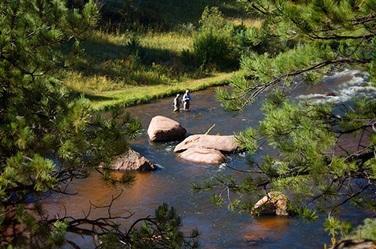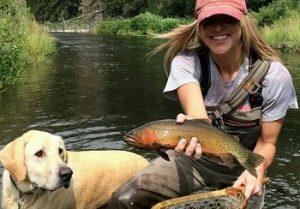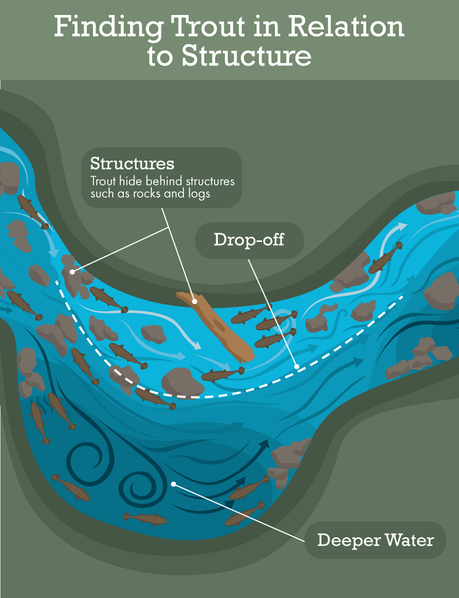Everyone that first starts Fly Fishing has dreams of landing 20+ inch fish, fighting down stream like Brad Pitt in “A River Runs Through it”, and landing that fish of a lifetime. However, while all that is possible. It is extremely unlikely. So I have put together some pretty basic tips and techniques that will get you on fish and build your confidence as a Fly angler.
Cut your Teeth on Creeks

Casting on rivers can be a daunting task, lots of water moving at various speeds, and it can be quite overwhelming to a beginner. So by going to a creek, you can focus more on your casting and less on everything else. Since creeks are smaller you will not need to get the fly out very far, and that makes everything all the more manageable so you can focus more on your presentation and controlling your line (Mending).
Choosing the right fly, for the right job can also be extremely overwhelming. I will tell you that there is no one fly that does it all, you have to learn a little about entomology (bugs) to better understand what you need. Creeks are mini-ecosystems and all you need to do is look at the world around you and you will see what you need to be throwing out there. Rather than laboring over books about insects and their habits, ask the people at local fly shops, they know what the fish are biting and what to use and they generally have no problem helping out rookies.
Without a doubt, reading the water is paramount to catching fish, it will do you no good to have a perfect cast and the right fly on if you are throwing it where the fish are not present. You will want to look for where water is moving the slowest, and the deepest. Trout like to hang out in areas where feeding is easy and requires the least amount of effort on their part, they are lazy when it comes to feeding. Spending a lot of time on creeks will help you learn to read even the most vast of rivers.
Understanding Your Prey: Trout

So now that you have made it to your favorite fishing hole on your favorite creek, you look down and you see absolutely nothing, not a single fish. Just because you do not see them, does not mean they are not there lurking about. Some of the largest fish I have caught on creeks have all surprised me because I had no idea they where there, until they struck my fly. Trout also have excellent underwater camouflage; if they can hide from eagles and bears, they can easily hide from us. So don’t fret, throw out a fly and see what happens.
80 percent of a trouts diet comes from subsurface insects and larva. When they strike a fly that mimics those underwater delicacies, they do so swiftly so setting the hook is not as difficult. The other 20 percent of the feeding will take place on the surface and this is where the challenge lies. Depending on what fly you are using, hoppers are generally sipped gently and flies are often attacked from below with force. The key is to be patient and do not set the hook too soon, and when you do set the hook…set it like you mean it, jerk that sucker. Trout have strong, thick mouths and you need to really get that hook in their good because when the fight is on the last thing you want to see happen is your line go limp because the fish came off.
Trout fishing changes with the seasons, and are based on the species you are targeting. Rainbows and Cutthroat trout generally spawn in the spring, while the monster brown trout do their spawning in the late fall. Fishing the spawning season is where you will most likely catch all the big fish, especially on creeks because they move into them to have more safety to spawn. Remember though, they are not feeding. So in order to land big trout during the spawn, you need to aggravate them with big streamers or egg patterns. In the summer, the fish tend to hold low and deep in pools, so seek out the holes and you will find fish. They love cold water and these holes give them both cold water and security. In the Fall, they tend to be more aggressive and will be all over the creeks and rivers, preparing for the winter where they feed almost entirely below the surface, but are still very active.
Reading the Water

Reading the water is by far the most important way to put yourself on fish. Learning to read the water is pretty simple, you just need to know what you are looking for. I will get you started on what got me on fish when I was learning. Look for big rocks, look for deep pools, and look for bends in the creek/river.
Big rocks in a river or creek create a pocket of slow moving water behind them. Trout love to hide around and behind those big rocks waiting for a nice tasty bug to float past them or over them so they get an easy meal. Cast around big rocks and try and get it as close as you can. If possible even let your fly float over the rock where a trout may be waiting in ambush.
I cannot stress finding deep pools or holes enough. Even on the tightest and smallest of creeks you can find very deep holes and big fish will most likely be there. As covered earlier, fish like the cold water and the security, so always be on the lookout for them. Some species of trout, like Browns, will spend their entire life living in or around the same hole. Once you find a hole, fish it for a while, and always try different flies before you move to your next spot…always be patient. You may land 2-3 smaller guys, but big daddy might still be lurking at the bottom.
Trout are lazy, they enjoy slow moving water to hang out in so they can feed while expending the least amount of energy possible. Bends in rivers, slow the flow of the river at the corner. It also generally creates deeper water due to the current, and we all know that trout like holes! Find and fish that deep water with subsurface nymphs or even worm imitations, but in the heat of a summer day don’t be afraid to toss out a hopper pattern. When the sun is out and the hatch is on, they will start to surface, so be prepared!
Controlling Your Line
Casting a perfect presentation, matching the hatch perfectly, finding the absolute perfect hole, means nothing if you do not maintain positive control of your line. Controlling or mending your line is without a doubt the most important thing you can learn about fly fishing. This is an area that I have started to devote a lot of time and energy into, because you cannot catch fish if you cannot control that line! The basics of maintaining proper control of your line are simple. Watch your line, water on rivers and creeks move at different speeds, and you need to constantly mend your line.
When you cast your fly out, your job is just beginning. You need to keep an eye on both your fly and your line as it they sit in or on the water. If your fly is not moving naturally in the water, the trout will ignore it every time. So stay vigilant about what your line and fly are both doing, because the line can and will change how the fly is being presented to the fish.
When you cast, often you are casting in holes where the water is moving a lot slower than where you are standing, which of course means your line will move at a different speed. When your line is moving faster than your fly, it will pull the fly in an unnatural way, and while trout are lazy they are also very smart and will avoid taking a fly that appears to be fake.
Once you have established where you want the fly to land, and how you want to fly to move then you can worry about mending the line. Mending is a series of techniques that will allow you to better control your line. You always want your fly ahead of your line, so if you see your line moving faster, pick it up and move it back where it belongs by doing a simple roll cast. If you are fishing below the surface, you also will be lifting the flies and resetting them to a more natural position.
Caring for Landed Fish

When I started out fly fishing, I came from salt water fishing. I did not fully understand how to handle fish I had caught, and mostly I did not catch and release. However as I have evolved as an angler, due to regulations and my own personal opinions, I have learned better ways to care for landed fish so that other anglers can enjoy the experience. Trout are a beautiful but very delicate fish, they cannot live long out of water, they are often hard to hold onto while trying to snap pictures, and the hooks on flies are small making the harder to remove.
Trout require water that is rich in oxygen and that is very cold. Removing them from the water for more than 15 seconds can kill a fish, even if you see it swim away. As the saying goes, “Keep ’em wet”, when you land them, keep them in your net and keep that net in the water! If you are going to keep them, do them a favor and kill them quickly and try not to let them suffer.
Everyone that fishes loves to “Fin and Grin” holding out their fish so they can show the world their catch. Keep them in your net and on the fly, and then turn the fish upside down while holding them underwater. Doing this disorients the fish, and will make them easier to hold when you take them out of the net to take a picture. When you are holding them, hold them gently, the tighter your grip the more the fish will feel distressed and it will want to wiggle away. Once the picture is taken, place them back in the net and in the water.
Now that you have finned and grinned and have decided to let the fish go, its time to remove that fly. We kept the fly in his mouth for the picture in case he wiggled away and you might still have a chance to get him back in the net again. If you are planning on catching and releasing fish, crimp your barbs, it will make it easier to remove. You need to invest in a good pair of forceps as well, the ones that lock. That way you can manipulate the fish, and the fly to remove the hook without risking the pliers coming off the fly. Keeping in mind this should be done with the fish in the water, or only removed from the water for short intervals.
My Final Thoughts
Fly fishing is not something you master quickly, and there is always more you can learn. Always keep an open mind, and understand that what works for some, may not always work for you. It truly is a deep and rewarding experience to catch a fish on the fly, and I know that with the proper practice, patience and studying anyone can land big fish.
Always practice, if you have a few moments on your lunch break, take out the rod and reel and tie some yarn on the end of your line and go try and catch some parking lot trout. If you have spare moments at home and cannot make it to the water, practice in your yard, grass trout are always biting. Challenge yourself, make up little games that push you and make you try different things. Above all when you practice, make sure you focus on the fundamentals, without them you cannot build on your techniques.
I know all fishing requires patience, but fly fishing DEMEANDS patience. You will make mistakes, you will lose flies, you will get snagged, you will not set the hook on that 22 inch Brown…and that is okay. Learn from the mistakes and always stay positive. A lot of fly fishing is having your head right, its a mental game. Staying optimistic and not giving up are key to catching fish. Just keep presenting that fly against all odds and sooner or later it will pay off.
When you have time, and you cannot practice because of the weather, and cannot fish because of other priorities, try and make the time to study. Read blogs, books, articles, magazines, anything you can get your paws on. Watch videos, YouTube has taught me A LOT and it can show you things that you may not understand from reading. Study the fish, study the insects, study the area you are going to be fishing, and always do so with an open mind.
Good luck out there, be safe and happy trails!

